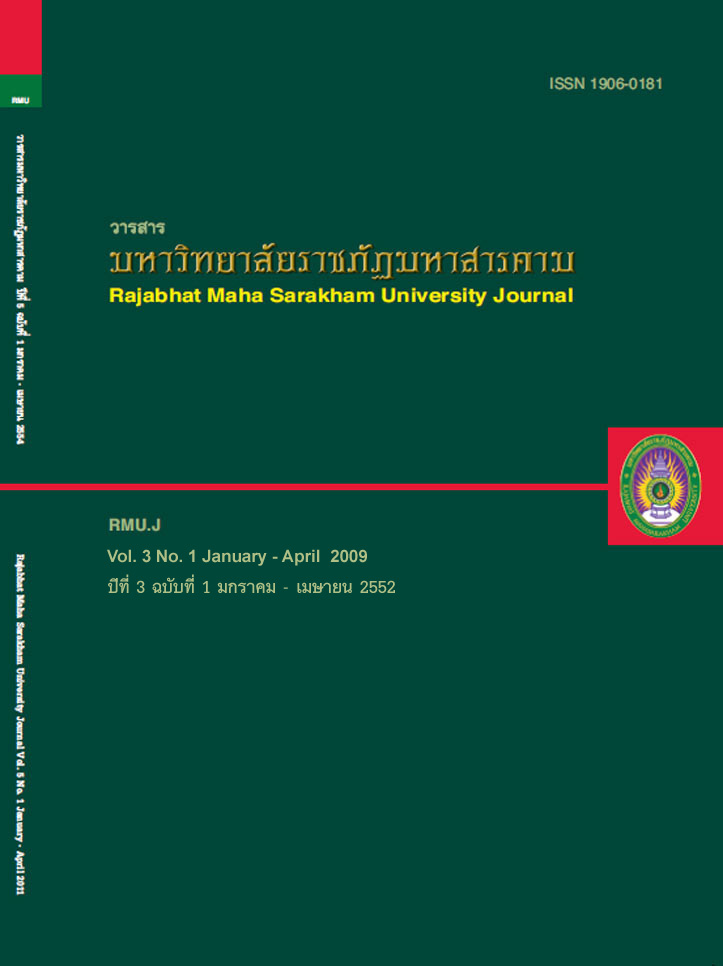การกระทำความผิดซ้ำของผู้ต้องขังในเรือนจำจังหวัดมหาสารคาม Repeated Offending of Jail Inmates in Maha Sarakham Provincial Prison
Main Article Content
บทคัดย่อ
การวิจัยนี้มีวัตถุประสงค์ ประการแรกเพื่อศึกษาสภาพแวดล้อมที่ผู้ต้องขังทำความผิดติดคุกซ้ำ ประการที่สองเพื่อเปรียบเทียบการกระทำความผิดซ้ำของผู้ต้องขังที่มีคุณลักษณะส่วนบุคคลที่แตกต่างกัน และประการที่สามเพื่อศึกษาแนวทางการ
ป้องและแก้ไขปัญหาการกระทำความผิดซ้ำของผู้ต้องขังในเรือนจำ กลุ่มตัวอย่างการวิจัย ประกอบด้วยผู้ต้องขังที่กระทำความผิดซ้ำในเรือนจำจังหวัดมหาสารคาม จำนวน 69 คน โดยการสุ่มแบบเจาะจง เครื่องมือการวิจัยเป็นแบบสอบถามแบบมาตราส่วน
ประมาณค่า 5 ระดับ และสัมภาษณ์เชิงลึก วิเคราะห์ข้อมูลแสดงเป็นค่า ความถี่ ร้อยละ ค่าเฉลี่ย ส่วนเบี่ยงเบนมาตรฐาน
การทดสอบสมมติฐานใช้ t-test (Independent sample) และ F-test (One Way ANOVA) ผลการวิจัยพบว่า
1. ผู้ต้องขังที่กระทำความผิดซ้ำในเรืองจำจังหวัดมหาสารคาม มีอายุระหว่าง 26-30 ปี ร้อยละ 53.60 เป็นเพศชาย
ร้อยละ 86.96 โสด ร้อยละ 50.70 จบมัธยมศึกษาตอนต้น ร้อยละ 30.40 กระทำความผิดจำนวน 2 ถึง 8 ครั้ง เป็นผู้ติดคุกซ้ำ
2,3,4 และ ครั้งที่ 8 ร้อยละ 56.50,17.40,11.60,4.30 และ 10.1 ตามลำดับ ระยะเวลาต้องโทษจำคุก น้อยกว่า 1 ปี, 1-5 ปี และ 5 ปี
ขึ้นไป ร้อยละ 4.30, 60.90 และ 34.70 ตามลำดับ ก่อนต้องโทษประกอบอาชีพ รับจ้างทั่วไป ร้อยละ 71.00 ฐานะทางครอบครัว
ระดับปานกลาง ร้อยละ 72.50 อาศัยอยู่กับบิดา มารดา ร้อยละ 56.50 และอยู่ในหมู่บ้านชนบท ร้อยละ 47.80
2. สภาพแวดล้อมการดำรงชีวิตนอกเรือนจำที่ผู้ต้องขังทำความผิดติดคุกซ้ำ 3 อันดับแรก คือ เศรษฐกิจของครัว
เรือนมีรายได้ต่ำ รายได้ไม่แน่นอนจากการรับจ้างทั่วไป สภาพทางกายภาพของครอบครัวส่วนใหญ่เป็นโสดอาศัยอยู่กับพ่อแม่
และสิ่งแวดล้อมชุมชนที่อยู่อาศัยมีแนวโน้มการพึ่งพาอาศัยตามรูปแบบดั้งเดิมของชาวชนบทในชุมชนปัจจุบันน้อยลงทั้งชุมชนใน
ชนบทและในเมือง ตามลำดับ
3. การเปรียบเทียบการกระทำความผิดซ้ำของผู้ต้องขัง พบว่า ระดับการศึกษา และจำนวนครั้งที่กระทำความผิดมีผลต่อการกระทำความผิดซ้ำแตกต่างกันอย่างมีนัยสำคัญทางสถิติที่ระดับ .05 ส่วนผู้ต้องขังที่มี เพศ อายุ สถานภาพสมรส
ระยะเวลาต้องโทษ อาชีพก่อนต้องโทษ ฐานะทางครอบครัว บุคคลที่ดูแลก่อนต้องโทษและสภาพแวดล้อมในชุมชนแตกต่างกันมีการกระทำความผิดซ้ำไม่แตกต่าง
4. แนวทางในการป้องกันการกระทำความผิดซ้ำของผู้ต้องขังในเรือนจำจังหวัดมหาสารคาม ควรมีการจัดโครงการกิจกรรมฝึกอบรม เพื่อพัฒนาสภาพจิตใจของผู้ต้องขัง การฝึกอาชีพภายในเรือนจำควรตรงตามความต้องการของผู้ต้องขัง และ
สามารถนำไปใช้ประกอบอาชีพได้จริงหลังพ้นโทษ และควรมีเยี่ยมบ้านเพื่อติดตามพฤติกรรมของผู้ต้องขังหลังพ้นโทษ
The purposes of this research were to: firstly, study the environment of jail inmates who
committed repeated offending; secondly, compare repeated offending committed by inmates who had
different personal characteristics; and thirdly, study approaches of prevention and solving of inmates’
repeated offending. The sample, purposively selected, comprised 69 prisoners who had committed
repeated offending in Maha Sarakham Provincial Prison. The research instruments consisted of a 5-level
rating scale questionnaire and an in-depth interview. The data analysis employed frequency, percentage,
means, and standard deviation. The testing of hypothesis employed t-test (independent sample) and F-test
(One-way ANOVA).
The results of the research are as follows:
1. The jail inmates who committed repeated offending in Maha Sarakham Provincial Prison were
26 – 30 years old, of whom 53.60% were male, 86.96% were single, 50.70% had completed lower secondary
education, 30.40% committed an offence for 2 to 8 times. Inmates who were imprisoned for the second,
third, fourth, and eighth time made up 56.50%, 17.40%, 11.60%, 4.30% and 10.10% respectively. The length
of imprisonment which was less than 1 year, 1-5 years, and more than 5 years made up 4.30%, 60.90%, and
34.70%, respectively. Prior to imprisonment, 71.00% had held temporary hired jobs, 72.50% were from
economically middle-level families, 56.50% lived with parents, and 47.80% lived in rural villages.
2. The top 3 environments outside the prison that the inmates who committed repeated
offending had lived were: the household’s economical status – their families had low incomes and the
incomes were not certain, due to the nature of temporary hired jobs; the family’s physical conditions –
most inmates had been single and had lived with parents; and the community environment – there had
been a trend that the mutually dependent rural life style would be seen less and less in both the rural and
the urban communities.
3. In the comparison of the repeated offending it was found that the level of education and how
many times the offences were committed affected repeated offending differently with statistical
significance at the level of .05. Meanwhile, the inmates with different gender, age, marital status, length of
imprisonment, occupation before imprisonment, family status, guardians before imprisonment, and
community environment, did not make any difference in repeated offending.
4. Approaches of prevention and solving of inmates’ repeated offending were suggested as
follows: projects with training activities aiming at spiritual development should be provided; career
training in the prison should meet the needs of the inmates and the inmates can really make a living with
that career after they are set free; aftercare programs should be carried out.
Article Details
1. บทความที่ลงตีพิมพ์ทุกเรื่องได้รับการตรวจทางวิชาการโดยผู้ประเมินอิสระ ผู้ทรงคุณวุฒิ (Peer Review) สาขาที่เกี่ยวข้อง อย่างน้อย 3 ท่าน ในรูปแบบ Double blind review
2. ข้อคิดเห็นใด ๆ ของบทความที่ลงตีพิมพ์ในวารสารมหาวิทยาลัยราชภัฏมหาสารคาม นี้เป็นของผู้เขียน คณะผู้จัดทำวารสารไม่จำเป็นต้องเห็นด้วย
3. กองบรรณาธิการวารสารมหาวิทยาลัยราชภัฏมหาสารคาม ไม่สงวนสิทธิ์การคัดลอกแต่ให้อ้างอิงแสดงที่มา


